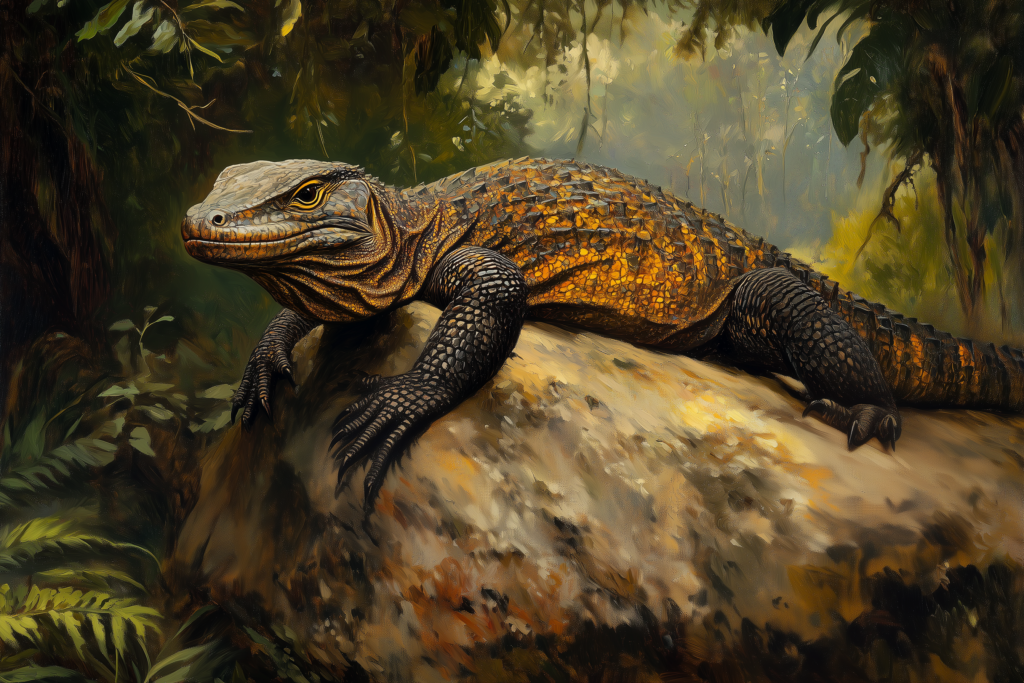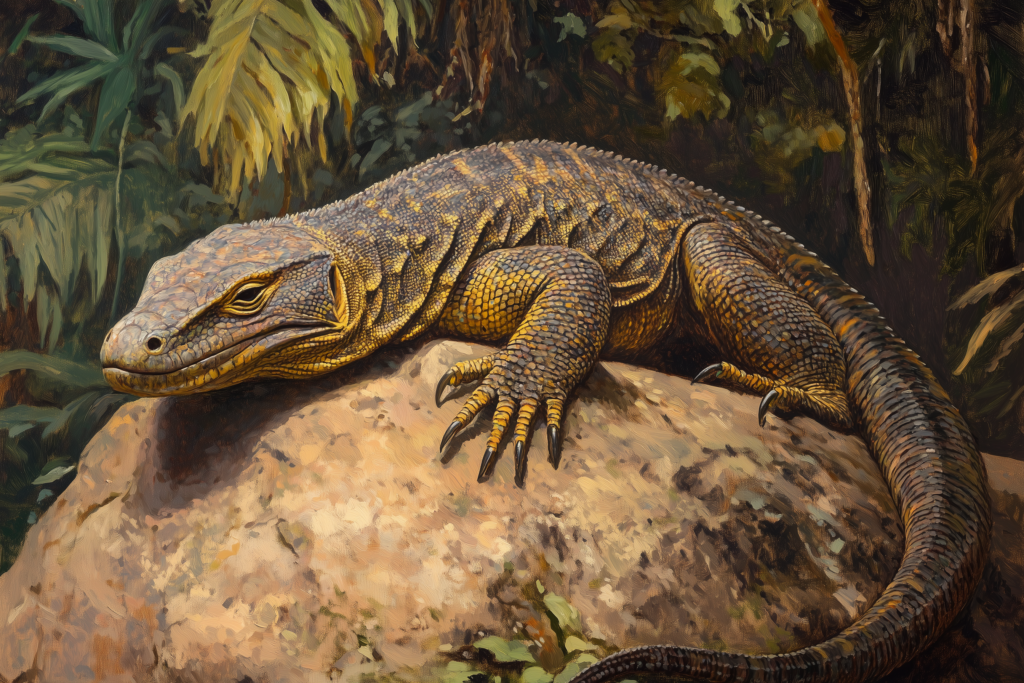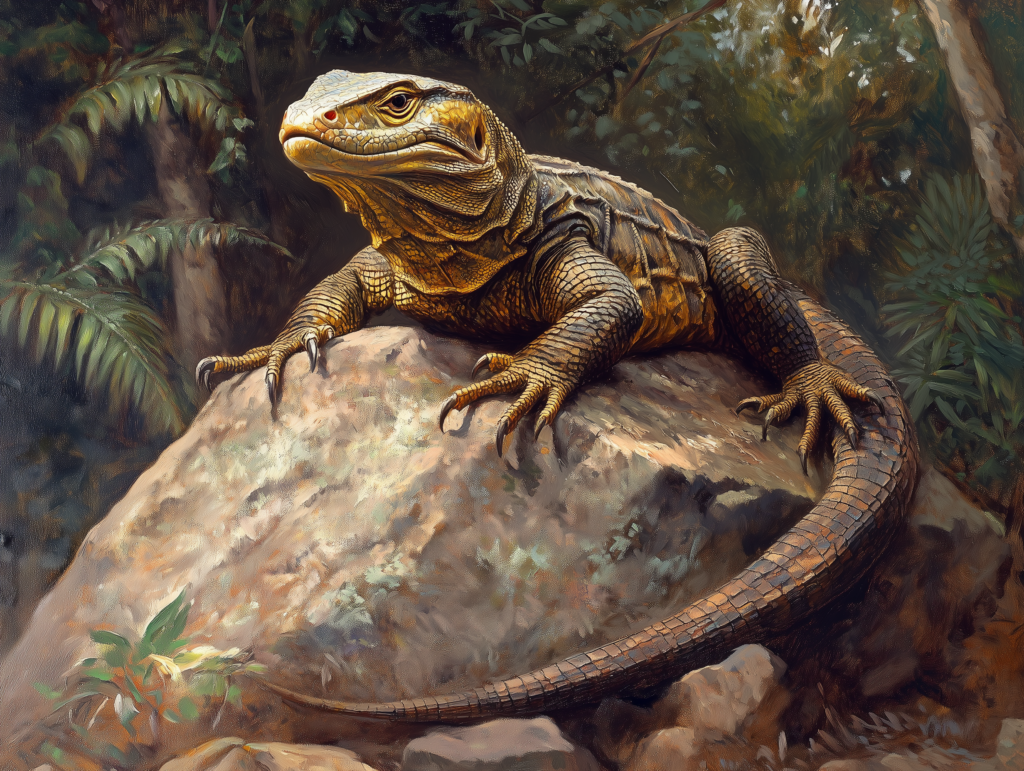Monitor lizards, Apex Stalkers of the Wilds
“Watch your step in the jungle. What you think is a fallen log might be a monster, just waiting to spring into action.”

Monitor lizards, belonging to the genus Varanus, are a diverse group of reptiles known for their striking appearance and remarkable behavior. They range in size from small, agile species to the colossal Komodo dragon. Their elongated bodies feature long, muscular tails, sharp claws, and elongated necks. Their tough, scaly skin comes in various colors and patterns, often camouflaging them in their environment. Some species, like the Komodo dragon, have a rugged, earthy tone, while others sport brighter hues for mating displays or camouflage.
These reptiles are highly intelligent, exhibiting problem-solving abilities and complex hunting techniques. They often display curiosity and are quick learners, which makes them stand out among reptiles. Monitor lizards are primarily carnivorous, feeding on insects, small mammals, birds, and even carrion, with some species also eating fruit. They hunt using their keen sense of smell, aided by their forked tongues that collect scent particles from the air.
Monitor lizards inhabit a wide range of environments, from tropical rainforests and savannas to arid deserts and coastal regions. Some species, like the Asian water monitor, thrive in or near water, using their powerful limbs for swimming and climbing. Others, like the desert monitor, adapt to harsh, dry conditions. They are territorial and often solitary, establishing home ranges they defend from other predators.
Their modus operandi for survival includes stealth and strength. They are skilled climbers and swimmers, often hunting from trees or water. Their powerful tails can serve as a defense mechanism or a weapon to strike threats. With high metabolic rates, some species, like the Komodo dragon, use ambush tactics, waiting for prey to come too close before attacking with a swift bite.
Motivated primarily by survival, monitor lizards are opportunistic hunters and fiercely territorial. Their drive for food, shelter, and mating is what fuels their solitary and sometimes aggressive behavior. They also display social interactions, such as dominance displays during mating season or territorial disputes, showcasing their complex social structures despite being largely solitary.
Monitor lizard 5e
Monitor lizard Pathfinder
Monitor Lizard

Large Beast, Unaligned
Armor Class 14 (natural armor)
Hit Points 85 (10d10 + 30)
Speed 40 ft., swim 30 ft.
| STR | DEX | CON | INT | WIS | CHA |
|---|---|---|---|---|---|
| 18 (+4) | 15 (+2) | 16 (+3) | 2 (-4) | 14 (+2) | 7 (-2) |
Skills Perception +4, Stealth +4
Senses Darkvision 60 ft., passive Perception 14
Languages —
Challenge 5 (1,800 XP)
Proficiency Bonus +3
Traits
Keen Smell. The monitor lizard has advantage on Wisdom (Perception) checks that rely on smell.
Hold Fast. The monitor lizard can use its claws to hold onto a surface or prey. As a bonus action, it can attempt to grapple a creature within 5 feet of it. If successful, the monitor lizard can move while dragging the grappled creature with it, using its movement.
Camouflage. When the monitor lizard is within 10 feet of natural terrain such as grass, rocks, or foliage, it has advantage on Stealth checks to hide.
Actions
Multiattack. The monitor lizard makes two attacks: one with its bite and one with its tail.
- Bite. Melee Weapon Attack: +6 to hit, reach 5 ft., one target. Hit: 15 (2d8 + 4) piercing damage.
- Tail Strike. Melee Weapon Attack: +6 to hit, reach 10 ft., one target. Hit: 12 (2d6 + 4) bludgeoning damage. If the target is a creature, it must succeed on a DC 14 Strength saving throw or be knocked prone.
Reckless Ambush (Recharge 5-6). The monitor lizard can unleash a sudden, brutal attack on an unexpecting target. It can make a bite attack and tail strike against a creature that has not yet acted in the combat. On a hit with either attack, the target takes an additional 10 (3d6) damage, and the target must make a DC 14 Constitution saving throw or become stunned until the end of its next turn.
Legendary Actions
The monitor lizard can take 2 legendary actions, choosing from the options below. Only one legendary action option can be used at a time and only at the end of another creature’s turn. The monitor lizard regains spent legendary actions at the start of its turn.
- Tail Lash. The monitor lizard makes a tail strike against a creature within reach.
- Vigilant Stalker. The monitor lizard moves up to half its movement speed without provoking opportunity attacks.
- Snapping Jaws. The monitor lizard makes a bite attack against a creature within 5 feet of it.
Tactics and Combat Behavior
The monitor lizard is a predatory creature, relying on its superior speed, stealth, and deadly physical prowess to take down its prey. It typically hunts by stalking and ambushing, using its Camouflage ability to blend into its environment and surprise unsuspecting foes. It prefers to strike when its target is unaware, utilizing Reckless Ambush for devastating damage early in the fight.
Once engaged in combat, the monitor lizard fights with brutal precision. It uses its Multiattack to tear into its enemies with its sharp bite and long tail, attempting to knock foes prone with a powerful tail strike. If it successfully grapples a target with Hold Fast, it uses its strength to drag its victim closer and continue the assault.
If cornered or threatened by multiple foes, the monitor lizard will prioritize its mobility, using its Vigilant Stalker to reposition itself quickly, ensuring it can strike from advantageous positions. It will use Tail Lash as a counter-attack to knock back foes that come too close, maintaining space to escape or reposition.
Motivation: The monitor lizard’s primary goal is survival. While it does not seek to fight unless necessary, it will defend itself with ferocity when provoked or when it is hungry. Its Reckless Ambush suggests a predator that capitalizes on the element of surprise, making it a dangerous foe when unprepared.
Environmental Adaptations and Preferences
Monitor lizards are highly versatile creatures, thriving in both forest and aquatic environments. In battle, they are at home in dense foliage where they can use their Camouflage to remain undetected. They will frequently seek out water sources, using their strong swimming ability to escape or gain the upper hand in combat. Monitor lizards are territorial and will defend their hunting grounds from other creatures or adventurers who dare to enter their domain.
Monitor Lizard

‘Monitor lizard’ – This immense lizard moves with a slow but relentless gait. Its feet end in large talons, and ropes of drool hang from its toothy maw.
Monitor lizards are large enough to pose a threat to humans, and in some societies are often mistaken for dragons. Some can reach lengths of 10 feet or more and weights of 350 pounds.
Monitor Lizard CR 2
XP 600
N Medium animal
Init +2; Senses low-light vision, scent; Perception +8
DEFENSES
AC 15, touch 12, flat-footed 13 (+2 Dex, +3 natural)
hp 22 (3d8+9)
Fort +8, Ref +5, Will +2
OFFENSE
Speed 30 ft., swim 30 ft.
Melee bite +5 (1d8+4 plus grab and poison)
STATISTICS
Str 17, Dex 15, Con 17, Int 2, Wis 12, Cha 6
Base Atk +2; CMB +5 (+9 grapple); CMD 17 (21 vs. trip)
Feats Great Fortitude, Skill Focus ( Perception)
Skills Climb +7, Perception +8, Stealth +10 (+14 in undergrowth), Swim +11; Racial Modifiers +4 Stealth (+8 in undergrowth)
SPECIAL ABILITIES
Poison (Ex)
Bite—injury; save Fort DC 14; onset 1 minute; frequency 1/hour for 6 hours; effect 1d2 Dexterity damage; cure 1 save. The save DC is Constitution-based.
| Monitor Lizard Companions |
Starting Statistics: Size Small; Speed 30 ft., swim 30 ft.; AC +1 natural armor; Attack bite (1d6 plus grab); Ability Scores Str 13, Dex 17, Con 12, Int 2, Wis 12, Cha 6; Special Qualities low-light vision, scent
7th-Level Advancement: Size Medium, AC +2 natural armor; Attack bite (1d8 plus grab and poison); Ability Scores Str +4, Dex –2, Con +4
ECOLOGY
Environment warm forests or plains
Organization solitary, pair, or pack (3–8)
Treasure none

 Buy me a coffee
Buy me a coffee